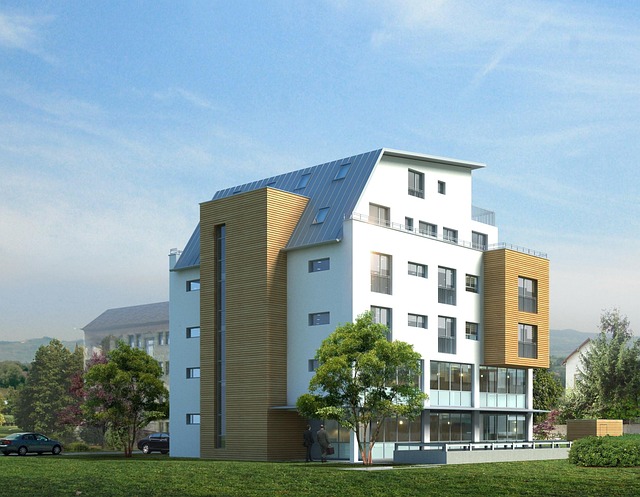Photorealistic architectural rendering has revolutionized design visualization, transforming how architectural concepts are presented. This advanced technology generates high-fidelity 3D images that closely mimic real photographs, showcasing textures and lighting accurately. By providing stakeholders with early, detailed insights, photorealistic renderings streamline project communication and decision-making, making them essential for both residential and commercial projects. Modern tools like ray tracing, global illumination, and AI-driven material simulation further enhance architectural CAD rendering, allowing architects to present visions with unprecedented accuracy and realism, improving client communication and project outcomes.
Photorealistic 3D renderings are transforming the way we visualize architecture, offering a revolutionary approach to architectural CAD rendering. This article delves into the art and science behind creating stunning visual representations for residential and commercial projects. We explore the process, benefits, and cutting-edge tools that drive this technology, highlighting its immense potential in design communication. From enhancing client presentations to enabling informed decision-making, photorealistic renderings are a game-changer in the industry.
Understanding Photorealistic Architectural Rendering: A Visual Revolution
Photorealistic architectural rendering has revolutionized the way we visualize and present design concepts, taking architectural CAD rendering to a whole new level. This cutting-edge technology allows architects, designers, and developers to create stunning visual representations that mimic reality almost perfectly. With photorealistic renderings, buildings and spaces appear as if they were captured through a camera lens, showcasing every intricate detail, from textures and lighting to shadows and reflections.
This visual revolution has transformed the industry by enabling stakeholders to make informed decisions earlier in the design process. By rendering photorealistic images and virtual tours, professionals can present their designs in a compelling and immersive manner, helping clients envision the final product with remarkable accuracy. The technology has also streamlined communication among project teams, as complex ideas can be quickly translated into easily understandable visual narratives.
The Process Behind Creating Stunning 3D Visuals for Projects
Creating stunning photorealistic 3D visuals for residential and commercial projects involves a meticulous process that combines artistic vision with technical precision. It all starts with gathering comprehensive project information, including architectural plans, material specifications, and lighting requirements from our clients. This data serves as the foundation for our digital masterpiece.
Next, using advanced architectural CAD rendering software, we bring these designs to life in three dimensions. Skilled artists meticulously model every detail, from intricate structural elements to subtle textural nuances. Lighting is carefully calibrated to mimic real-world conditions, enhancing the depth and realism of the image. Finally, through a series of fine-tuning iterations, we ensure the final renderings not only accurately represent the project but also captivate the viewer with their photogenic quality.
Benefits of Using CAD Renderings in Residential and Commercial Design
In today’s competitive markets, showcasing a project’s vision is paramount for both residential and commercial designs. Architectural CAD renderings offer an unparalleled way to present ideas, providing clients with a clear and realistic understanding of the final product. The photorealistic quality of these renderings allows designers to showcase intricate details, textures, and lighting effects, setting their projects apart from mere blueprints or sketches.
Beyond aesthetic appeal, CAD renderings streamline communication between architects, developers, and clients. They enable efficient decision-making by facilitating early project evaluations, identifying potential issues, and allowing for necessary adjustments before construction begins. This not only saves time but also ensures that the final product aligns with all stakeholders’ expectations, making architectural CAD renderings an indispensable tool in modern design processes.
Tools and Technologies Shaping the Future of Realistic Visualizations
The future of photorealistic visualizations is being shaped by advanced tools and technologies, revolutionizing how we perceive and interact with 3D models. Architectural CAD rendering has evolved from simple wireframes to highly detailed, realistic images that mimic actual photography. This transformation is driven by powerful software that utilizes sophisticated algorithms and GPU acceleration to render intricate scenes with remarkable accuracy.
Technologies like ray tracing, global illumination, and AI-driven material simulation are pushing the boundaries of what’s possible in architectural visualization. Ray tracing, for instance, accurately reproduces light behavior, creating shadows and reflections that appear natural and dynamic. Combined with high-fidelity textures and realistic lighting models, these tools enable architects and designers to present their visions in a way that was once unimaginable, fostering better client communication and project outcomes.
Photorealistic 3D renderings, powered by advanced architectural CAD rendering technologies, are transforming how we visualize residential and commercial projects. By accurately representing design concepts, these tools enable better decision-making, enhance client communication, and ultimately drive project success. As technology continues to evolve, the future of architectural visualization looks even more promising, promising greater realism, efficiency, and creativity in the design process.
